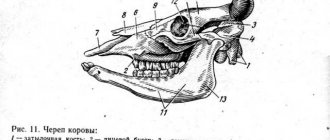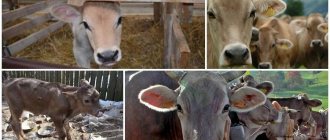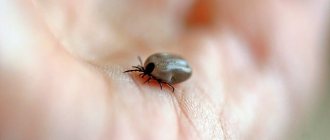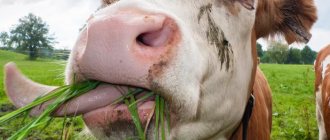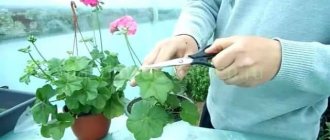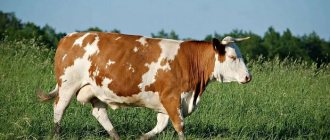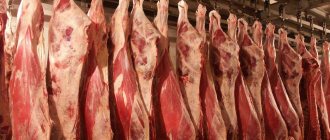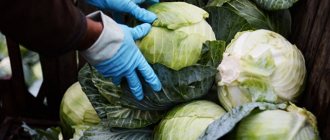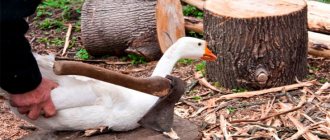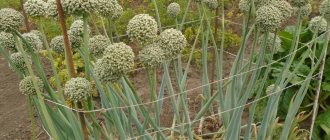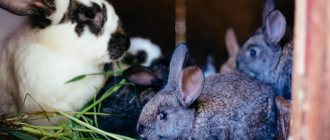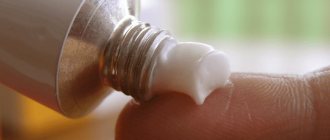To obtain cattle carcasses, animals must be transported to specially equipped enterprises (slaughterhouses or meat processing plants). In some regions, independent slaughter of livestock on private farms is allowed. This process requires certain knowledge and preparation, as it must be carried out quickly and, if possible, painlessly for the animal.
You will find useful recommendations for preparing bulls and cows for slaughter in this article. It also describes the most common slaughter technologies, as well as methods for cutting up carcasses and processing hides.
- Skinning
- Bull preparation
- Skinning
Preparation for slaughter
Preparation begins not with the animal, but with the performer. Slaughtering a cow, especially at home, is an unpleasant and difficult task. People with weak psyches are not recommended to slaughter a cow with their own hands. It is best to trust the professionals. There are numerous meat processing plants and factories where you can deliver a prepared bull for slaughter and cutting. This, as well as the subsequent processing of the skin, can bring more profit than selling it yourself.
Veterinarian's permission
If the cow is slaughtered at home, then, first of all, you need to contact a veterinarian for the appropriate permission. It will be issued after a detailed examination of the animal, which will demonstrate the presence or absence of diseases.
Also, in order to enjoy beef, you must provide information about all vaccinations. This is intended to prevent the owner from killing a sick animal and then selling its meat contents. Here the presence of a stigma will come to the aid of doctors. A similar designation on a bull helps the veterinary service:
- Monitor dangerous diseases using an internal database;
- Ensure clean meat products reach the market.
Cow preparation
One day before slaughter, you should refuse to provide the cow with food. There are no restrictions on drinking, because it is necessary to cleanse the digestive tract of food debris. This element is called pre-slaughter. The presence of semi-digested feed in the stomach or intestines before slaughter can lead to complications during skinning and cutting of the carcass.
In addition, there is a possibility of contamination of meat tenderloin with the filling of internal organs. Other preparations for slaughter should take place away from animals. Often domestic bulls sense a person’s mood, so they begin to resist. In this case, you should avoid prodding, kicking, pushing and handling the cows calmly. Harmful substances released by the cow during stress must not be allowed to enter the blood from the heart. A balanced mental state of the animal is called a prerequisite for high-quality slaughter.
How to slaughter goats for meat
The principle of slaughtering a goat is close to a similar procedure for other ungulates. The general algorithm looks like this.
| 1 | A day before the procedure, the goat must be placed in a separate room for sitting. It is possible - in a separate compartment of the barn, but it is better to isolate the goat from the herd and by sound. The animal must stop feeding. There is no need to limit water; you can add a laxative. |
| 2 | When the sitting period ends, the goat's legs are tied and placed on either side. |
| 3 | The goat is raised to a height where its head is located in line with the knees of an adult. For successful lifting, it is convenient to use a crossbar. |
| 4 | The individual is held tightly by the head. Make a puncture with a sharp knife below the ear, near the corner of the lower jaw. The knife should not be narrow, as when slaughtering pigs; A wide knife works well. |
| 5 | Without removing the blade, it must be supported with the back side against the vertebrae. With a sharp movement, cut off the bloodstream of the neck. |
| 6 | The goat carcass is left to drain the blood. The process takes up to 10 minutes, but you need to make sure that blood clots do not clog the bloodstream or slow down the drainage process. |
| 7 | Blood, if necessary, is collected in a container and filtered for further purification. |
Goat slaughter
The next steps are skinning and butchering the carcass. They do not differ from similar procedures for a bull, described in detail in the first part of the article. Let us only note that the esophagus must be tied with a cord first, preventing the leakage of waste products.
Butchering a goat
There are different slaughter methods for different domestic animals. Each has its own rules and characteristics. They are united by one common condition: it is necessary to approach the process with knowledge of the matter, so as not to cause unnecessary suffering to living creatures and not to complicate the task for yourself. By following simple rules, a farmer can even handle cattle on his own. But if he does not feel confident in his abilities, then he should use the services of a factory or slaughterhouse.
Slaughter process
Having understood how to properly prepare a bull for slaughter, you should learn some recommendations on the slaughter process itself, so that this will help bring less suffering to the livestock and complications for yourself.
The animal's horns are attached to supports so that the head is well fixed. A sharp, deafening blow is applied to the frontal part with a heavy object in the form of a sledgehammer (weighing at least 2 kg) or a stun gun is used. While the cattle is unconscious, it must be quickly slaughtered. Therefore, the lower part of the bull’s throat is immediately opened with a cross-section of a sharp knife, damaging all the vessels. To drain the blood, prepare a deep container in advance. After the animal is slaughtered, complete bleeding occurs within ten minutes. This method can also be used to slaughter cows.
Using a stun gun
The use of a stun gun in slaughtering livestock began relatively recently, but this method has already gained popularity in small households. The humaneness and ease of the process simplifies the procedure for slaughtering cattle. The stun gun stuns the bull for some time, during which time you need to kill the animal. The advantage is that not everyone is able to deliver an accurate and heavy blow with a sledgehammer; a person can miss, cause unnecessary pain to the bull, or even kill it. To prevent such a situation, they began to use a stun gun. But you need to know that if you give an extra discharge of current, the animal’s blood may begin to clot, which will spoil the quality of the meat. The device should be placed behind the ear, where the sensitive part of the body is located. The stun gun is used not only to slaughter bulls, but also to slaughter pigs and even chickens.
Slaughter using a buterol with a cutter
A buterol with a cutter is a butcher's hammer on a handle, weighing 2.3 kg and 0.9 m long, having a cone-shaped cutter at one end and a hook at the other. The fighter places the bull's head and hits it hard with the buterol, plunging the incisor into the middle of the forehead or between the horns into the back of the head. An animal with a broken skull falls, then a willow rod is inserted into the hole to destroy the medulla oblongata, after which the cervical vessels are cut, and the animal dies very quietly, as with an injection into the occipital foramen. This method is also accompanied by damage to the brain, and most importantly, it requires great dexterity on the part of the fighter, since any unsuccessful blow leads to torment for the animal. In addition, the meat is not sufficiently bled, and therefore becomes tasteless.
Veterinary technique
This technique involves the use of specialized medications that are administered by injection. This leads to the immobilization of cattle for a certain amount of time, during which it is necessary to proceed directly to bleeding and cutting up the carcass.
The use of this technique is accompanied by increased risks during the bleeding procedure. This is due to the ambiguous reaction of each individual individual to the administered drug. In this regard, it is necessary to take additional safety measures when carrying out work. Also, the introduced drug negatively affects the taste of meat products.
Carcass processing
Before cutting, you need to make sure that all the blood is drained. How long does this last? Typically, these processes are short and take place in ten minutes. After this, you can begin cutting up the cow's body.
Skinning
Butchering a bull or cow begins with removing the skin. First, the ears are cut off, and the skin near the nostrils and lips is cut using a ring-shaped method. The incision then continues from the right nostril to the right horn. From there it is applied to the forehead. Under the horn, a good guide is the notch left after trimming the ear. A circular cut is made at the base of the horns. When part of the head has been cut, the incision is made to the middle of the lower lip, removing the last sections of skin. To simplify the procedure, you can turn the carcass on its back. Afterwards, the head is separated and the skin is cut according to the following scheme: from the sternum and belly, peeling off the ribs, all the way to the anus.
The legs are separated along the line of the wrist joints. The incision is made along the inside, connecting with previously made cuts just above the place where the hoof is located. In this case, damage to the tendons should be avoided. Painstaking and careful work with the limbs of cattle will eliminate problems with hanging. Afterwards, the cover is removed from the chest (in the area of the ribs), the lower part of the neck, and the incision is directed to the groin. You can’t rush to remove it here, because the skin is delicate. The cuts are made with the whole blade after tension by hand. Muscles appear between the ribs. Even the skin of a dairy calf is removed in this manner.
Skin dressing
For dressing, the skin of the bull is removed from the back using both hands. A clean skin for dressing is folded in half along the length of the spine, leaving the wool on the outside.
It is necessary to immediately remove meat parts and remaining fat. The skin is left to cool for a couple of hours, after which it is salted. In order to tan the skin, you need to wait three to seven days so that it is completely dry. Then you can take it to a procurement point or make it yourself. This material is often used in the leather or fur industry.
For example, the skin of a newborn calf is highly durable and has a smooth surface. Using embossed molds, you can even imitate crocodile skin! Cured calf skin can also be used for other types of this material, for example, nappa or velor.
Removing the entrails
After removing the skins, they begin to extract the entrails. First, the internal organs of the cow are removed from the chest cavity, then from the abdominal cavity. This operation should be carried out no more than an hour after slaughter, so that microorganisms living in the intestines do not get into the meat tenderloin. The insides are laid out separately. The cow's heart along with its lungs is placed in a sterile container intended for internal organs. In this case, the diaphragm is cut off at the ribs themselves. Next comes the extraction of the liver and gall bladder.
Carcass cutting
The carcass is always cut with continuous movements across the grain. It all starts near the 13th and 14th vertebrae - the line between them is cut in half. Then all parts are cleaned of meat, bones, fat, tendons, films, and fibers. After deboning and stripping the neck, the cow's meat is cut into pieces. In this case, it is necessary to remove the blade. The ribs are scraped out partially or completely. This choice of cleaning ribs depends on the type of meat. During boning of the back of the spine, bones are removed. Then come the top parts, drumstick, brisket and lastly the meat cut from the shoulder bone.
Veterinarian's opinion
After the operations have been performed, the carcass is examined by a veterinarian. If he does not detect the presence of pathologies, then cutting is carried out along the entire length of the ridge. At the exit, the carcass is transported to the refrigerator for 24 hours to dry and cut between the ribs into quarters.
Now the question is “How to slaughter a bull or a cow?” doesn't seem difficult. All you need for this is a hammer, coordination and a strong psyche. The slaughter technology was examined in detail, which will help avoid mistakes during slaughter and dressing. A correctly carried out procedure will ensure maximum meat yield. Now, homemade veal and beef is not something fantastic.
Providing the consumer basket with meat products directly depends on the slaughter and processing of cattle. Delicious beef and veal dishes are largely thanks to livestock breeders who know how to properly slaughter bulls and cows.
How to slaughter poultry
Poultry slaughter is a procedure quite different from animal slaughter. The preparation of the animal and the “working space” is no different, and the slaughter process itself is completely different. There are 2 basic principles for performing this simple procedure.
Poultry slaughter
External principle
The procedure for implementing this principle.
1The bird is secured upside down in a specially designed cone. The head is pulled through the lower opening. They stun with a strong blow.2A deep cut is made with a sharp knife just below the ear
Left or right - it doesn’t matter. 3 They make a sharp movement in order to cut the carotid artery and vein. It is advisable to do this the first time.4 The carcass is left directly in the cone to allow the blood to drain.5 When the blood has completely drained, the bird is removed from the cone and prepared for the plucking procedure.
Poultry in a cone for external slaughter
Internal principle
This principle is implemented as follows.
| 1 | The bird is hung upside down and stunned with a strong blow to the head. |
| 2 | Scissors are inserted into the beak. Blood vessels are cut. It is advisable to do this in one motion. |
| 3 | The scissors are directed towards the cerebellum and pierce it. The procedure is completed, the scissors can be removed. |
| 4 | The bird is left suspended, allowing the blood to drain. |
| 5 | When the blood has completely drained, the individual is removed and prepared for plucking. |
Piercing the cerebellum is important for proper slaughter
Due to the need to insert scissors into the beak, this method is difficult to use with chickens, quail and other small birds. It is inconvenient to use small scissors, and large ones simply do not fit into the bird’s throat. Therefore, for small birds, the second principle of slaughter will be preferable.
Division into varieties
Every experienced housewife knows that there are different types of beef. But as practice shows, for some reason most people are sure that the division into grades refers to the degree of freshness of cow meat.
In reality, the grade only tells you what part of the carcass the flesh is cut from. The type of beef has nothing to do with the freshness of these parts. There are 3 grades in total - the highest, first and second. So that you do not make a mistake when choosing, we have prepared a short list:
- The back flesh near the ridge is the highest grade;
- Brisket – premium quality;
- Sirloin and sirloin – premium quality;
- Rump and rump are the highest grade;
- Scapular and subscapular parts – 1st grade;
- Neck and flank – 1 grade;
- Front and hind shanks – 2nd grade;
- Cut - 2nd grade.
The type of beef is, of course, an important, but not the primary factor when choosing. First, remember - calves are always better than adult bulls or cows. The meat of calves is pink and soft. A grade 1 shoulder or neck from a calf will almost certainly be much tastier than the back or breastbone of an old cow, although technically they are of the highest grade. And secondly, it is better to take your own meat for each dish, and we will talk about this later.
Mini slaughterhouse for cattle
After the cattle has grown to slaughter age, the animal can be delivered to a meat processing plant. However, it is much more profitable to use your own mini-slaughterhouses. They have a modular composition. Modular mobile workshops are equipped with all necessary equipment.
It includes the following modules:
- for slaughter;
- for primary processing of carcasses.
It can be equipped with a module for the production of semi-finished products. For example, in such modules you can stew meat and produce stew.
Raising cattle is quite a profitable business. Therefore, having acquired the skills of slaughtering animals, you can obtain high-quality meat, both for your own consumption and for sale.
0 0 votes
Article rating
Slaughter process
The slaughter of cattle is usually carried out by specialized enterprises. In most cases, cows are transported by various means directly to the slaughter site. After they arrive at the enterprise, a certain list of activities is carried out.
Initially, it is necessary to restore the physical performance of livestock. To do this, he is given 2 to 3 days to recover. In parallel, work is underway to sort livestock, including conducting a veterinary and sanitary examination. While waiting for slaughter, cattle are put into starvation mode. And immediately before the slaughter, approximately 2-3 hours, the supply of drink stops.
The slaughter procedure consists of the following steps:
The individual is stunned using one of the previously mentioned methods. The next stage is the implementation of measures to bleed the carcass. Subsequently, the skin is removed
This procedure must be performed with extreme caution. Removing the skin containing elements of the fat layer and meat fibers is accompanied by a decrease in commercial quality
At the same time, damaged muscle fibers contribute to the introduction of various microorganisms, which lead to rapid spoilage of meat. The final stage is gutting. In this case, the internal organs are removed, and the carcass is cut into separate parts, depending on the total mass. In this case, this procedure should be carried out no later than 45 minutes after the animal is bled. For the convenience of carrying out all necessary operations, the carcass is suspended at a certain height.
The final quality of the product, as well as the overall percentage of meat obtained, depends on the correct observance of all stages of slaughter.
Slaughter with skull crushing
The bulls are driven into a narrow passage, and the leading bull himself steps onto a movable platform, where he is secured behind and in front with bolts, and his head is tightly tied between two vertical iron beams. The platform with the bull descends along a rail inclined plane, at the end of which there is a massive iron beam, against which the bull seems to crush his entire skull. The bull immediately falls and his neck vessels are cut, and then the platform rises up behind the next bull.
Methods and methods of cow slaughter
There are several ways to kill cattle. In slaughterhouses they use a special stun gun, and in private households they use hunting weapons, or by cutting the carotid arteries.
Preparatory stage
Cattle must be kept on a fasting diet for 12-24 hours before slaughter. At this time, feeding is completely excluded, and watering is not limited. Fasting a cow is necessary for the most complete bowel movement of the digestive tract in order to facilitate subsequent cutting and prevent the contamination of the carcass with pathogenic microorganisms. Prolonged fasting (over 24 hours) leads to serious exhaustion and weakening of the animal - cows lose meat yield. But pre-slaughter dehydration is even more harmful - it leads to difficulty in skinning and a decrease in muscle moisture and overall weight.
Immediately before killing, cattle are washed. This also helps prevent microflora and dirt from getting on the meat. Afterwards, the livestock is examined by a doctor or veterinary assistant. Temperature measurements are required and accompanying documentation is examined.
Slaughter with preliminary stunning
Stunning cattle allows you to reduce stress in the animal, improve bleeding, and also improves worker safety. To induce a coma, carbon dioxide, electricity, pneumatic or conventional blows to the forehead are used. Stunning allows you to immobilize the bull, while maintaining cardiac activity, which improves subsequent bleeding.
The most common, accessible and practical method is the use of electric current. A bull for slaughter is driven into a box, its chest limbs stand on a grounded stand, and the workshop operator pierces the skin on the animal’s neck with an electrode. Full immobilization time:
- 8-10 seconds for calves;
- more than 10 seconds for bulls and cows.
The method of immobilization with a hammer blow is used much less frequently. To perform Rausch anesthesia, you need a wooden hammer weighing up to 2 kg and a long handle (about 1 m). The diameter of the hammer is at least 10 cm, the striking edge is convex. Do not use metal, narrower or pointed hammers - they can easily break the skull. The blow is applied above the eyes to the frontal lobe.
It is important to clearly calculate the force of the blow, otherwise you can either damage the brain or insufficient anesthesia. The cattle are secured in the pen, it is important to secure the head firmly by the horns and neck
An incorrect blow worsens bleeding and brings suffering to the animal. A number of slaughterhouses use pneumatic hammers. They allow you to adjust the impact
The cattle are secured in the pen; it is important to firmly secure the head by the horns and neck. An incorrect blow worsens bleeding and brings suffering to the animal.
A number of slaughterhouses use pneumatic hammers. They allow you to adjust the blow.
The use of carbon dioxide, medications and other methods is not widely used in the practice of slaughtering cattle. Sometimes a 70% mixture of carbon dioxide and air is used to put the cow into a comatose state.
Methods without preliminary stunning
They are used for door-to-door slaughter when anesthesia is not possible. Disadvantages of this method:
- poor bleeding and large blood losses without the possibility of subsequent commercial use;
- animal anxiety;
- injuries to personnel;
- deterioration of meat quality.
Slaughter of livestock by bleeding is still practiced in private farmsteads. It is also used for ritual purposes in a number of religious sects, where it is considered the only true one. To perform it, it is necessary to cut the cervical blood vessels. The blow is delivered behind the lower jaw below the spine. Usually the carotid artery is pierced, and after bleeding the trachea and esophagus are cut. An even more painful method is to cut the neck along the branches of the lower jaw to the spine. The animal behaves restlessly, collecting blood is difficult, and there is a great danger for humans, especially when slaughtering a large bull.
Also, home slaughter uses a technique similar to the use of an air gun in a slaughterhouse. The slaughter of a bull is carried out by a shot from a gun. You need to aim 5-8 cm above the eyes (the point of intersection of the lines from the horn to the opposite eye). If the bullet enters lower, it can pass without hitting the brain. In addition to the fact that the method requires the use of an additional tool, the main problem is the difficulty of bleeding - it occurs after cardiac arrest and the meat can be filled with blood.
Slaughter with Bruno's mask
A killing mask, or as others call it, a “buterol with a mask,” is made of leather or copper and placed on the bull’s head. The mask, which also covers the animal’s eyes, is secured with straps in such a way that a metal plate, sewn into the skin and having a round hole in the middle, fits exactly in the middle of the forehead. A chisel is inserted into this round hole, which ends on the outside with a round button. A strong blow with a wooden hammer (Bruno's buterol, weighing 2.3 kg and 30 cm long) drives this chisel 25 cm into the brain. A strong probe (or willow rod) is inserted into the hole made in the skull in order to destroy the medulla oblongata from the side cerebral hemispheres. This operation lasts from 30 to 40 seconds, and often more. After the brain is destroyed, they begin bleeding by cutting the cervical vessels.
Speaking about the evaluation of this method, it is necessary to mention that damage to the cerebrum does not always lead to loss of consciousness. This is proven to us by the mass of cases known in surgery. In general, as we know, it happens that people experience extensive damage to the large brain that occurs during life without any symptoms, and they learn about them only after death. Therefore, Bruno’s method cannot be considered the most rational. If we take into account that even with this method the brains are made unfit for sale, and due to damage to the blood centers with subsequent paralysis of blood vessels, bleeding is greatly delayed, then it becomes clear why this method, which initially caused a lot of noise when tested in various slaughterhouses in Europe, has found its way application in France alone. It was also tried in St. Petersburg slaughterhouses, but it turned out to be very troublesome, slow and in many respects unsuitable for Russian bullfighters.
Slaughter
So, we have decided on the characteristics and qualities of the product; it’s time to discuss the correct process for preparing and cutting the meat itself.
Timing and principles of selection
Obtaining tasty and high-quality rabbit meat is directly determined by feeding and breeding methods. Until recently, it was believed that slaughter should begin at 4 months of an animal’s life. But success in the field of genetic engineering and the creation of many meat breeds with excellent early maturity, the development of new types of food (compound feed) and new feeding methods made it possible to begin slaughtering much earlier, starting from the second month of the animal’s life.
Rabbits in a cage
Small farms practice slaughtering animals in the third month of life, when they reach a weight of up to 2.5 kg without significant fat deposits. Animals during this period have a slaughter yield of up to 50% (the amount of meat per carcass). In hybrid meat breeds (for example, Californian), the yield is 5% higher.
Adult
It is worth considering that age does not benefit the quality of the animal’s meat. Since both the chemical composition of the product and its proportion of fat change. With age, the amount of liquid in meat decreases, the caloric content and energy value of the product, and the proportion of fat and protein in it increases.
Start of slaughter
Before preparing for slaughter, stop feeding the animal 12 hours before the procedure; it is also necessary to clean the animal’s skin with a regular brush, which will reduce debris and dirt during cutting.
Next you need to grab the animal by the hind limbs. The animal will resist at first, wait until it calms down, then strike the area behind the animal's ears with a regular stick. The spinal cord ruptures, after which the animal dies. You can tell that an animal is dead when it starts bleeding from the nose and ears.
A freshly killed specimen with traces of blood on its head
Alternative methods of killing:
- blow to the skull with a hammer;
- striking the parietal region or the area between the ears and eyes with the edge of the palm;
- an option not for the impressionable in the form of neck twisting, for which it is enough to grab the area from the back of the head to the chin with your right hand, twisting your neck to the side;
- an archaic version with an electric shock in the area of the animal’s temple.
Collapsing neck
Gutting and skinning
For ease of understanding, we will describe the process step by step:
Step Description Photo 1 Before skinning, you need to prepare a clean and convenient board for cutting the carcass. We place the carcass on it, pinch the skin of the animal on the back and make a cut.
2 The cut is made, now you need to grab it with your fingers, gradually introducing the fingers of different hands there. After entering, we begin to pull them in opposite directions. The movements should be sharp and strong; you should not worry that part of the skin will remain on the carcass (usually the paws). With proper force, the tail can be separated without additional effort. Then you need to break the paw bones at the ankles, and then help yourself with a knife, cutting the remaining flesh.
3 Separate unnecessary limbs. You need to cut off the head, the cut line should run along the first cervical vertebra. If the tail does not come off when peeling off the skin, cut it off with a knife.
4 Removing internal organs
To do this, pay attention to the animal's abdomen; you will see a clear white line. It is along this that you need to make a careful cut right down to the bones of the sternum. You should be extremely careful when manipulating, in no case should you damage the urinary and gall bladders
The meat will lose its taste if the contents of these bubbles end up on the meat. To find the gallbladder, pay attention to the liver area, in rabbits it is located nearby
You should be extremely careful when manipulating; under no circumstances should you damage the urinary and gall bladders. The meat will lose its taste if the contents of these bubbles end up on the meat
To find the gallbladder, pay attention to the liver area, in rabbits it is located nearby
5 Before cutting meat, pay attention to the internal organs of the animal. A healthy animal has a juicy red liver, in which case you can safely use the carcass for food
Along with the blisters, the liver should also be separated from the carcass, but not as waste, but on the contrary, one of the most delicious parts of the animal’s body. Lungs, kidneys and internal fat can be either removed or left; they will not spoil the taste of the animal, and are rarely prepared separately.
Skinned rabbit
How rabbits are beaten for meat
To get a high-quality skin from a rabbit, you need to wait for a complete change of hair. If you plan to use only meat, then you can cut the rabbit at any time of the year. As soon as he looks sufficiently well-fed, the necessary procedure can be carried out.
Butchered rabbit carcass
General procedure.
112 hours before the procedure, you need to stop feeding the rabbit. This will allow him to empty his intestines. There is no need to limit your drinking. Adding salt to the water by analogy with poultry is also pointless.2 The rabbit is held firmly by the hind legs in a motionless position.3 The most appropriate method of slaughter is chosen. This could be a blow to the back of the head with a stick, a blow to the skull with a hammer, twisting of the neck, a stun gun, or a puncture with a knife.
If it is important for a person that the process be painless, then the rabbit must be stunned with a strong blow, and then quickly slaughtered. Any option is simple to implement, but unpleasant due to the small size of the rabbit and its mobility
Therefore, farmers often choose the services of professionals.4 The individual is hung on a hook for 5 minutes to drain the blood. Then the skin is removed, singed and the carcass is cut up.
Rabbits are slaughtered not only for meat, but also for their skins.
Livestock preparation
Pre-slaughter holding of an animal involves drinking plenty of water and not eating to cleanse the digestive tract of food debris. The presence of semi-digested food in the intestines or stomach can lead to problems during dressing and skinning. In addition, undigested feed residues can contaminate the cut of meat.
Other preparations for the slaughter of cattle should be carried out at a distance from the animals. Domestic bulls and cows sense a person's mood and can resist. To avoid such a situation, cattle should not be kicked, prodded or pushed, otherwise harmful substances released during stress may enter the bloodstream. A prerequisite for high-quality slaughter is a balanced and calm mental state of the animal.
Stun gun
Slaughtering cattle using this method is considered the most humane. A rod with exposed electrodes is placed on the animal’s head, close to the ear, to paralyze and stun it, rather than kill it. The throat of unconscious cattle is cut to bleed them out. An electric shock is not enough to kill a cow - it can only stun it. If the applied voltage increases, the blood may clot, making the meat unfit for consumption. You can assemble a stun gun for slaughtering cattle at home.
Slaughter methods
The procedures for slaughtering cattle at meat processing plants and at home differ. To avoid unnecessary suffering, animals are stunned before slaughter. At home, hitting cattle in the forehead with an ax or sledgehammer is common. Before slaughter, the cow is tied with its horns to any support. After this, a blow with a blunt object is performed on the forehead.
For maximum efficiency, it is recommended to use a tool weighing at least two kilograms. Some slaughterers use a sharpened dagger when slaughtering livestock. The place of impact when using this technology for cattle slaughter is the back of the head, or more precisely, the depression between the occipital bone and the cervical vertebra.
Many farmers, especially beginners, cannot determine the exact time of slaughter of a piglet or an adult boar. The optimal weight before this procedure also raises questions. General recommendations are as follows: the approximate weight of an adult pig suitable for slaughter is 110 kg, about 75 of which is pure meat and lard. Piglets are raised to 50-60 kg.
Well-fed pig, suitable for meat
Important factors determining the success of the slaughter procedure:
- Feeding the pig must be stopped 12 hours before the procedure so that it cleanses its intestines (besides, it will be easy to lure it out with food);
- You should not shout at the animal, kick it or push it, so as not to cause stress;
- immediately before slaughter, the pig must be washed (the carcass will be easier to process, the meat will be of higher quality);
- the place for the procedure must be chosen in such a way that it is easy to wash and tidy;
- The container for collecting blood is prepared in advance, because the blood most often goes to the sausage.
Next, we will consider 4 common methods of slaughtering a pig.
Neck piercing
To implement this method you need 2 people. The first one secures the individual by the legs, the second one stabs the neck. The knife should be long and thin, the blade length should be at least 30 centimeters.
| Step | Description |
| 1 | To carry out a puncture, you need to place the animal on a table or other surface. If the piercer is right-handed, then the pig's head is on the right side. |
| 2 | It is necessary to prepare a container for collecting blood in advance. |
| 3 | You should imagine a conditional line from the left ear to the throat of the pig. |
| 4 | You need to make a sharp injection with a knife into this line, at a distance of no more than 3 centimeters from the ear. |
| 5 | After the puncture, the pig will be shocked. You need to quickly put it on its side (preferably the left one), take it by the back leg and press it firmly to the surface. The blood will drain quickly and the pig will fall asleep in a matter of seconds. |
The pig must be tied and placed on its side
Heart puncture
| Step | Description |
| 1 | The individual is tied by the limbs. It is highly advisable to tie all 4 legs. |
| 2 | Helpers grab the pig by the limbs and hold it. If there is only one assistant, then he must hold the hind legs. |
| 3 | The animal is turned over on its side (right), a thinner knife, 30 cm long, is taken and an injection is injected directly into the heart. It is difficult to make a mistake, since the heart is located between the 3rd and 4th rib, similar to a human one. Everyone remembers the location of the human heart from anatomy textbooks; in a pig everything is exactly the same. |
| 4 | The blade is not removed, but kept inside until the individual stops moving. |
| 5 | At the end, the knife is removed using a cloth, strong or folded in 2-4 layers. You need to prepare the fabric in advance. |
Heart puncture is a common method of slaughter
Meat knife
Stun gun
This method is considered to be not the most humane. But for the slaughter of large wild boars it is sometimes indispensable. Even 3 adult men cannot always cope with a large, strong animal, and it is simply impossible to do it alone. The principle of operation is extremely simple. The pig is stunned with a stun gun and the carotid artery is cut while it is unconscious. As an option, sometimes a puncture is made in the heart.
Electroshock is often used to slaughter pigs.
This method is not recommended, as it is inhumane and inconvenient. If the pig senses danger, it will run and be difficult to hit. Trying to kill a pig can injure and cause suffering, and there is a risk of damaging other animals or property. Therefore, the method is considered unsuccessful. But when executed correctly, its effectiveness cannot be denied.
Pork carcasses hanging after slaughter
How to kill a bull correctly
Killing a bull is not easy. The main problems are the large size of the artiodactyl, its remarkable strength and endurance. Few people manage to quickly kill a bull without experience. Therefore, beginners “suffer” with the animal for a long time, receiving a strong psychological burden from this. It is recommended to take the bull to a slaughterhouse, to a factory, where experienced specialists will cope with the task much faster and more humanely. If you decide to slaughter a bull yourself, then you must carefully follow all 3 stages of this difficult process.
Adult bull
Preparation of the artiodactyl
Before the slaughter procedure, care must be taken to properly prepare the animal. The process includes a number of required factors:
- Diet expansion. We add healthy supplements to food and increase the volume of greens.
Add more greens to your diet
- Separation from other animals. The bull should not be taken away from the animals immediately before slaughter, but 1-2 days earlier. This will allow it to be at rest, producing less hormone.
We separate from other animals
- Compliance with optimal slaughter times. It is recommended to slaughter the bull in the first year. But if he was born in the spring, slaughter should be postponed until late autumn. In the initial six months of its existence, the calf rapidly gains weight. In addition, autumn meat tastes much better and is higher in calories.
In the first six months, the calf rapidly gains weight
- No castration. If a born calf is initially being prepared for slaughter, it is not advisable to castrate it. Surgical intervention should be resorted to only in extreme cases. In general, uncastrated bulls grow meat faster and more actively.
Castration is not necessary if the calf is initially raised for meat.
Stun
Stunning is a mandatory step. Humanism is not the only reason for stunning; there are others. Thus, a awake and active bull at the time of slaughter produces a huge amount of the hormone. The hormone makes meat less tasty and soft, and its large proportions can even harm the human body.
The bull must be tied before stunning
They stun large animals with a blow to the head with a large stick or the butt of an ax. The blow should be strong and sharp so that you don’t have to hit it several times. If you are concerned about the animal's experiences, you need to try to ensure that the first blow plunges it into unconsciousness. Then the bull will not feel anything and, in fact, will simply fall asleep.
Ax head stun
Slaughter
You need to start the main stage immediately as soon as the artiodactyl has lost consciousness. After 3-4 minutes the individual may come to its senses, and this should not be allowed. It is necessary to act quickly according to a clear algorithm.
Use of blood from slaughtered animals
How to cut a carcass and how to properly process the skin?
First of all, you need to do the skin, and then proceed to the other steps. The skin is carefully folded along the midline, which passes through the projection of the spine. The fur should be facing outward. In this form, the cover must lie for several hours for cooling to occur. Subsequently, the skin will need to be salted.
While the skin is resting, you can start carcassing. All internal organs are removed first.
It is necessary to carefully remove the stomach and intestines, since if these hollow organs are accidentally damaged, their contents can spill out and spoil the valuable meat
The gastrointestinal tract is immediately washed with copious amounts of water. Then the remaining organs are gradually isolated and removed. All parts of the animal that are subsequently expected to be eaten must be carefully examined by a veterinarian, who must be present at this stage of cutting. Only after inspection and a verdict on whether the meat is suitable or not can cutting continue.
The carcass is cut in half along the spine and placed in a special refrigerator to mature the meat. Subsequently, the meat is divided according to a special scheme.
Skinning and dressing
Removing the skin from a carcass is called skinning. Removing the skin from a carcass is a simple process, but it requires care and attention. In a hurry, you can damage it, depriving it of its presentation, and contaminate the meat with microbes.
Skinning the head is a separate stage of work. The ears are cut off and the skin is removed through an incision in the frontal part.
At home, work is carried out with the animal positioned horizontally on a straw or wooden flooring:
- The carcass is placed on its back, with wooden blocks placed under its sides. They cut off the head and bandage the esophagus remaining on the body so that its contents do not stain the meat when cutting.
- Using a cutting knife, cut the skin lengthwise from the throat to the anus.
- On each leg, a circular cut is made around the hooves.
- The skin is cut on the inside of the limbs from the top to the hooves.
- Using a knife and prying the skin with your fingers, they remove it from the carcass. They begin processing the front legs, then move on to the neck and chest, moving towards the hind legs.
- They remove the skin from the sides to the spine, and then pull it from the neck to the butt, trimming it with a knife if necessary.
Watch the video below on how to skin cattle:
Cow cutting
Before cutting, the carcass must be completely drained of blood. To do this, it is suspended vertically, and a clean basin is placed under the incision to drain the blood. Typically this process takes 10 minutes.
Skinning
After the cow is slaughtered, the skin is removed from the animal using a sharp knife. First, the ears are cut off, and then circular cuts are made around the nose, mouth and horns. Removal begins from the head. Then an incision is made between the head and the cervical vertebrae, and the head is separated from the carcass.
Further skinning is carried out as follows::
- The headless carcass is placed on its back onto special drains;
- A circular incision is made around the anus;
- Circular incisions are made around the joints, and longitudinal incisions are made along the legs to the abdomen;
- The lower hock joints on the legs are cut off.
Figure 2. Cutting a cow carcass
After this, they begin to remove the skin, first from the legs, then from the neck and sides, then from the chest and move to the back.
Carcass cutting
Cutting up a cow carcass begins with opening the chest. They split it with an ax, then bandage the trachea and remove it along with the stomach.
Note: The trachea must be tied to prevent the contents of the stomach from contaminating the meat.
The internal organs are removed from the chest and placed in a separate sterile container. During the cutting process, a veterinarian must be present who can confirm the quality of the meat. If no pathologies are found, the carcass is divided into two half-carcasses with a saw and sent to the refrigerator. Figure 2 shows what parts a beef carcass consists of.
Proper stunning of livestock
First of all, the animal must be securely restrained. To do this, its horns must be firmly fixed to the support. This should be done carefully, otherwise the animal may become agitated and break free.
To stun, use a wooden hammer or other blunt, hard object. The weight of the device must be 2 kilograms or more, the blow must fall in the center of the forehead.
Some slaughterers prefer to use a sharp object to strike at the junction of the occipital bone and the first cervical vertebra. Finding the right place is quite easy, and getting into it is also not difficult. During a stun, you need to act decisively and quickly, without hesitation. If you don't hit hard enough, you will hurt the animal instead of knocking it unconscious. Think in advance if you can do this.
All preparations must be carried out away from the place where the animal is kept, otherwise the bull will feel danger and will worry. This will lead to many problems. An agitated large animal will be more difficult to secure and strike. In addition, stress negatively affects the quality of the meat product.
Slaughtering bulls at home - video
Slaughtering bulls at home is no different from slaughtering a cow. The only difference is that an adult bull is much stronger than a cow, and serious difficulties are possible in the process. That is why it is recommended to carry out this procedure at specialized enterprises.
Slaughtering bulls is a psychologically difficult task, as can be seen from the video. We recommend that children and people with weak mental health not watch this video.
https://youtube.com/watch?v=PpLYksyag3I
Bull preparation
When preparing a bull for slaughter, his diet includes more concentrates and green feed, which will improve the quality of the meat. It is recommended to send one-year-old bulls to slaughter, as they grow quickly, but do not consume as much feed as adult animals.
Figure 3. Methods for stunning a bull
Before slaughter, the bull cannot be fed for 24 hours, but is given plenty to drink. Preparing the bull also includes setting up a special place (if the procedure will be carried out at home) and consulting a veterinarian, who must issue the appropriate permission.
Stun
The slaughter of a bull in domestic and commercial conditions is carried out using stunning (Figure 3). To do this, use a heavy wooden hammer, which is struck firmly in the center of the forehead. You can also use an electric shock or a sharp dagger, which is used to make a deep puncture in the area of the transition of the back of the head to the cervical vertebra.
When the animal has lost consciousness, all other procedures must be carried out quickly until the animal wakes up, so all the necessary equipment is prepared in advance.
Slaughter
Once stunned, the bull will only be unconscious for a few minutes. Therefore, immediately after striking, they begin directly to slaughter. To do this, the carcass is hung up and a cross-section of the neck is made with a sharp knife, opening the blood vessels.
A clean basin is placed under the carcass to drain the blood. Bleeding lasts on average 10 minutes. After this, the carcass begins to be cut up.
When is the best time to slaughter a bull?
Experienced livestock breeders recommend slaughtering a bull at one year of age. During the first year of life, the animal quickly gains weight, while the cost of feeding it is not too high. In the future, the weight gain does not increase so actively. However, bulls born in spring should be slaughtered later - closer to autumn. This recommendation is justified - in the summer, the animal receives a lot of plant food, due to which it quickly gains body weight, while the quality of the meat improves.
Attention! Uncastrated bulls gain weight faster, so you should refrain from this procedure.
The slaughter procedure is carried out in the morning, when it is still cool enough and there are no flies. It is important to consider that cutting a carcass will take about three hours, and for an inexperienced person even longer.
Russian technique
This technique has become quite widespread. This is due to the speed of the process, as well as the involvement of a small number of people. It will take no more than 10 minutes to slaughter a cow. If you have practical skills, you can slaughter 10 individuals in 1 hour.
Let's take a closer look at the algorithm for this type of slaughter:
- The essence of the method is to quickly insert a dagger into the space between the occipital bone and the first cervical vertebra. To do this, you must use a sharpened blade with a length of at least 26 centimeters.
- The animal is first brought into the slaughter chamber. It provides special fasteners for the floor covering.
- Initially, the cattle's horns are tied, followed by pulling the cow's head to the floor. This is necessary for the convenience of striking with a dagger. At the same time, additional measures are being taken to prevent cattle from falling over. They involve the use of a special block with pins, which is installed under the groin of the animal.
- Immediately after wedging the blade into the occipital region, they begin to strike with a wide knife in the lower region of the neck, directing the tip towards the location of the heart.
- As a result, a large flow of blood will gush out, which is accompanied by bleeding of livestock. The resulting meat products are distinguished by juiciness and high quality meat.
